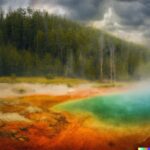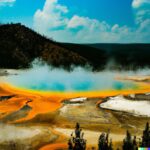Have you ever wondered why Yellowstone National Park is renowned for its spectacular geysers? In this article, we will explore the fascinating world of geysers, the unique geology of Yellowstone, and how this iconic park came to be.
From the formation of the Yellowstone Caldera to the different types of geysers found within the park, we will delve into the significance of these natural wonders and why they are an essential part of Yellowstone’s ecological landscape.
So, join us on a journey to discover the wonders of geysers in Yellowstone and how you can experience them firsthand.
What Are Geysers?
Geysers are spectacular natural phenomena found in various locations worldwide, including the iconic Yellowstone National Park.
These incredible geological features are formed when underground water encounters hot rocks, causing it to boil and create pressure. The pressure eventually builds up until the water bursts through a narrow opening in the Earth’s crust, resulting in a spectacular eruption of steam and water.
One of the most famous geysers in Yellowstone National Park is Old Faithful, known for its regular and predictable eruptions, captivating visitors with its impressive displays. Geysers play a crucial role in maintaining the delicate balance of geothermal systems, offering researchers valuable insights into the Earth’s inner workings.
What Makes Yellowstone Unique?
Yellowstone National Park stands out as a geological wonder, renowned for its exceptional concentration of geysers, hot springs, and other thermal features.
These geothermal attractions not only provide visitors with breathtaking natural displays but also serve as a reminder of Yellowstone’s volcanic landscapes, shaped by millions of years of geologic activity.
The park’s unique geological history can be seen in its colorful hot springs, towering geysers like Old Faithful, and intriguingly diverse terrain. Exploring Yellowstone offers a glimpse into the Earth’s powerful forces, making it a must-visit destination for nature enthusiasts and anyone captivated by the fascinating wonders of our planet.
What Is The Geology Of Yellowstone?
The geology of Yellowstone National Park is a testament to its extraordinary geothermal activity, featuring captivating geologic wonders and unique geological formations.
This geothermal activity stems from the park’s underlying magma chamber, responsible for powering its hydrothermal systems and geologic hotspots. The prominent features such as geysers, mud pots, and hot springs are a result of this geological activity, creating a dynamic and ever-changing landscape.
The environmental significance of these geological features cannot be overstated, as they provide habitats for unique microbial life forms adapted to extreme conditions and play a crucial role in maintaining the park’s delicate ecological balance.
How Was Yellowstone Formed?
The formation of Yellowstone dates back to ancient geological events influenced by intense tectonic activity and the presence of a massive underground magma chamber.
These geological processes played a pivotal role in shaping Yellowstone’s landscape over millions of years. Tectonic movements, including the shifting of large plates beneath the Earth’s surface, led to the uplifting of the land and the creation of vast mountain ranges in the region. In conjunction with this, volcanic eruptions from the magma chamber resulted in the deposition of layers of volcanic rock and ash, forming the foundation of Yellowstone’s unique geology. The interaction of these forces gave rise to the park’s iconic features like geysers, hot springs, and colorful thermal pools.
What Is The Yellowstone Caldera?
The Yellowstone Caldera is a massive volcanic feature that defines the park’s landscape, harboring intense geothermal heat and serving as a geological hotspot of remarkable significance.
Formed over two million years ago during a series of explosive volcanic eruptions, the Caldera spans a vast area of nearly 35 by 45 miles. Its geothermal activity is evident in the colorful hot springs, bubbling mud pots, and iconic geysers like Old Faithful. This geothermal heat beneath the surface plays a crucial role in shaping Yellowstone’s mesmerizing geologic landscape, influencing the unique land formations and supporting diverse ecosystems within the park’s boundaries.
What Are The Different Types Of Geysers In Yellowstone?
Yellowstone hosts a diverse array of geysers, ranging from the iconic Old Faithful to the stunning Grand Prismatic Spring and the powerful Steamboat Geyser.
These geysers exhibit fascinating characteristics that set them apart from each other. Old Faithful, for instance, is known for its regular and predictable eruptions, shooting water up to 184 feet into the air. In contrast, the Grand Prismatic Spring showcases stunning rainbow-colored waters due to its mineral-rich deposits. Meanwhile, Steamboat Geyser stands out for its sporadic but immense eruptions, sometimes reaching heights of over 300 feet. Each geyser holds its unique geological significance, contributing to the dynamic and ever-changing landscape of Yellowstone National Park.
Why Are There So Many Geysers In Yellowstone?
The abundance of geysers in Yellowstone can be attributed to its location atop a geological hotspot, fostering a rich geothermal environment that fuels the park’s geologic wonders.
This unique position is a result of the park sitting above the Yellowstone Hotspot, which is a massive plume of hot molten rock rising from deep within the Earth’s mantle. The intense heat from this hotspot fuels the underground reservoirs of boiling water that eventually erupt as the spectacular geysers that we see throughout the park. The presence of fault lines and fractures in the Earth’s crust in this region allows for efficient circulation of water, creating the perfect conditions for geysers to form and thrive.
What Is The Hotspot Theory?
The Hotspot Theory offers insights into the formation of geysers in Yellowstone, attributing their presence to the upwelling of hot mantle plumes beneath the Earth’s crust.
These hot mantle plumes are believed to originate from deep within the Earth, creating a hotspot that results in significant geothermal activity in the Yellowstone region. As the mantle plume rises, it heats up the surrounding rock layers, causing them to melt and generate magma. The intense heat and pressure build up until the magma is forced upwards, eventually reaching the surface through cracks in the Earth’s crust. This process results in the formation of geysers, such as the iconic Old Faithful, which erupt periodically due to the pressure release of the hot water and steam trapped underground.
What Is The Role Of The Yellowstone Caldera?
The Yellowstone Caldera plays a pivotal role in shaping the park’s geologic processes, offering a natural laboratory for in-depth geologic studies and research.
With its immense size and volcanic history, the Caldera has influenced the formation of iconic features like the geysers, hot springs, and mud pots found throughout Yellowstone National Park. Geologists can examine the unique rock formations, hydrothermal features, and volcanic deposits within the Caldera to unravel the complex geological history of the region. This geological wonderland provides valuable insights into the Earth’s processes, aiding scientists in understanding volcanic activity, tectonic movements, and the evolution of landscapes over time.
Why Are Geysers Important To Yellowstone?
Geysers hold immense importance for Yellowstone due to their environmental significance and role in showcasing the park’s mesmerizing geothermal wonders.
These natural hot springs not only captivate visitors with their awe-inspiring eruptions but also play a crucial role in maintaining the delicate ecological balance of Yellowstone. The unique combination of heat and water in geysers creates a habitat for specialized microorganisms that thrive in extreme conditions, contributing to the park’s biodiversity. The mineral deposits left behind by geyser activity form colorful terraces and formations, adding to the visual splendor of the landscape. Through their dynamic interactions with the environment, geysers exemplify the raw power and beauty of nature in its purest form.
What Is The Ecological Impact Of Geysers In Yellowstone?
Geysers in Yellowstone play a vital ecological role, influencing thermal pools, supporting diverse ecosystems, and contributing to the park’s geothermal activity.
These geysers provide a source of heat and minerals that help maintain the delicate balance within the thermal pools, fostering unique microorganisms and creating an environment conducive to specific plant species. The interaction between geysers and thermal pools not only shapes the landscape but also influences the distribution of flora and fauna, with some species relying on the warm waters for survival. The geothermal activity fueled by geysers helps regulate underground systems, impacting the overall biodiversity of the area.
How Do Geysers Attract Tourists To Yellowstone?
Geysers serve as alluring attractions that draw tourists to Yellowstone, captivating visitors with their geologic wonders and establishing the park as a premier tourist destination.
These natural marvels are renowned for their majestic displays, shooting columns of steam and water high into the air, creating a mesmerizing spectacle. Visitors flock to iconic geysers like Old Faithful, which consistently erupts on schedule, offering a reliable and impressive show. The sulfurous aroma that fills the air, the vibrant colors of microbial mats surrounding the geysers, and the bubbling pools add to the unique appeal of these thermal features. Their unpredictable yet awe-inspiring nature adds to the thrilling experience of exploring Yellowstone’s diverse landscape and reinforces its status as a must-visit destination.
How To Visit And View Geysers In Yellowstone?
Visiting and experiencing geysers in Yellowstone is a memorable adventure that offers a glimpse into the park’s extraordinary geothermal features and geological marvels.
There are several prime locations within Yellowstone where visitors can witness the mesmerizing display of geysers. One of the most famous spots is Old Faithful, known for its predictability in eruptions. The Upper Geyser Basin is a fantastic area to explore with a concentration of various geysers like Grand Geyser and Riverside Geyser. It’s essential to maintain a safe distance from these geothermal features as they can emit scalding hot water. To fully appreciate the beauty of geysers, consider visiting during the early morning or late afternoon when the lighting enhances their natural colors.
What Are The Best Geysers To See In Yellowstone?
Exploring Yellowstone’s best geysers offers a firsthand encounter with geologic marvels, geothermal attractions, and the park’s renowned geologic hotspots.
- Witnessing the majestic eruptions of Old Faithful, a symbol of Yellowstone’s volcanic activity, highlights the park’s dynamic landscape. The geyser erupts predictably, shooting water up to 180 feet in the air every 60-110 minutes, captivating visitors with its impressive display.
- The Grand Prismatic Spring astonishes with its vibrant rainbow hues, representing one of the largest hot springs worldwide. Its unique microbial mats create a kaleidoscope of colors, making it a must-see attraction for those fascinated by the intersection of geology and biology.
What Safety Precautions Should Be Taken When Viewing Geysers In Yellowstone?
Ensuring safety when viewing geysers in Yellowstone is paramount due to the unpredictable nature of geothermal features, boiling water, and ongoing geologic processes.
- Visitors to Yellowstone National Park must remain on designated boardwalks and pathways to avoid the risk of stepping on fragile ground that may conceal scalding hot springs.
- The water emitted by geysers can reach temperatures exceeding boiling point, making it imperative to maintain a safe distance to prevent accidental burns.
- The ground surrounding geothermal features may be unstable, posing a danger of collapse.
- Respect for warning signs and barriers is crucial for safeguarding oneself and preserving the natural wonders of the park.
What Is The Future Of Geysers In Yellowstone?
The future of geysers in Yellowstone holds promise for further exploration of geothermal resources, geologic events, and ongoing geologic studies within the park.
Given the increasing global focus on sustainable energy sources, it is likely that geothermal utilization in Yellowstone will continue to expand, with advancements in technology enabling more efficient harnessing of the park’s geothermal energy.
Ongoing geologic research in Yellowstone can provide valuable insights into the Earth’s processes and help us better understand natural phenomena. As geysers evolve over time, monitoring these changes can offer a glimpse into the dynamic nature of geological formations and contribute to the scientific community’s knowledge base.
Last Updated on February 8, 2024 by Jon Waraas – Originally Posted: February 8, 2024

I’m Jon Waraas, and I’ve been navigating the online world since 2006. By day, I’m the proud owner of some eCommerce gems, and by night, I’m the voice behind the adventures on Waraas.Com.
My heart, however, belongs to the wild beauty of Yellowstone National Park. I’ve got a collection of websites dedicated to sharing the wonders of this natural masterpiece. Oh, and did I mention? I’m currently building my own cabin inside the ghost town of Gilmore, Idaho – a cabin with tales to tell!
When I’m not immersed in the digital realm, you’ll find me lacing up my boots for a good hike or setting up camp under the star-studded sky.




